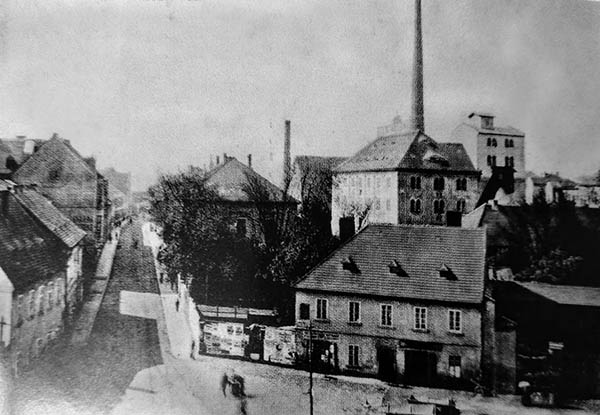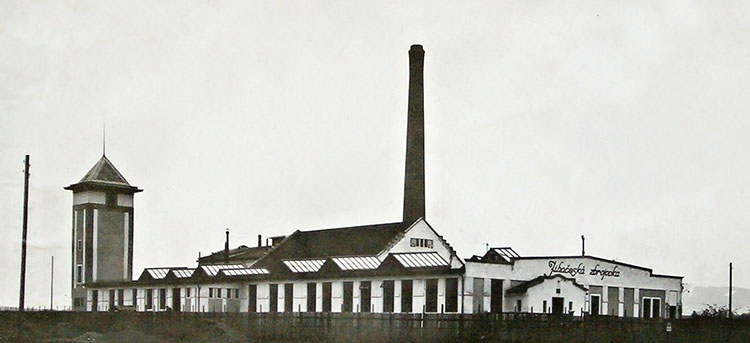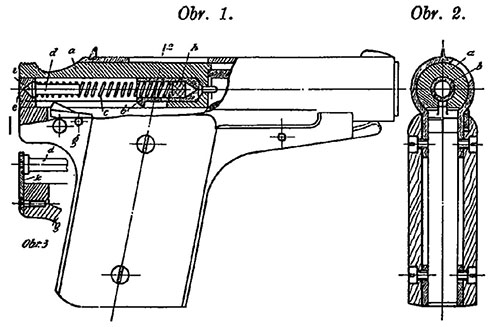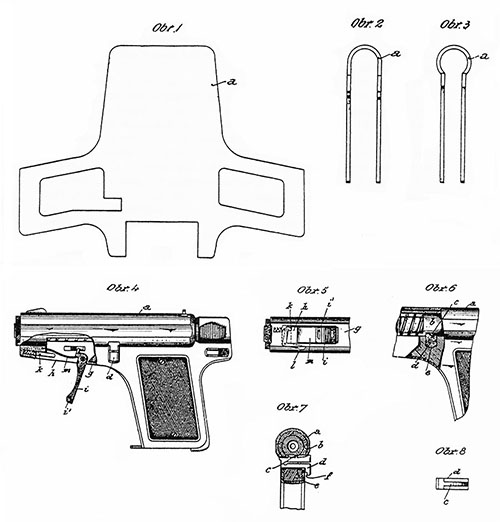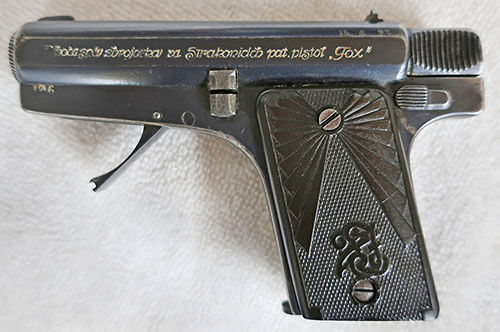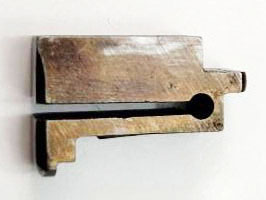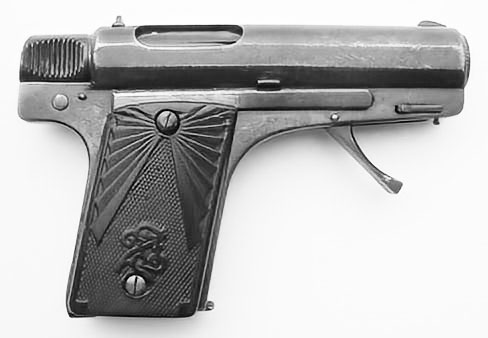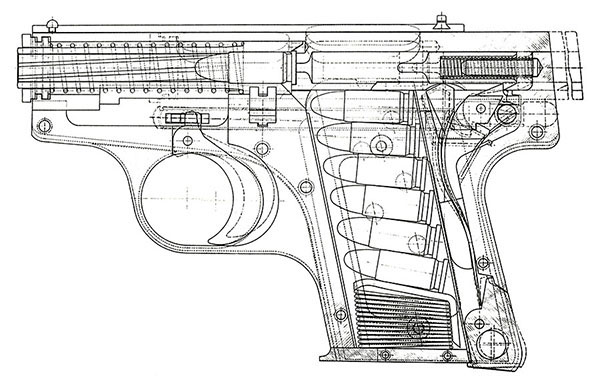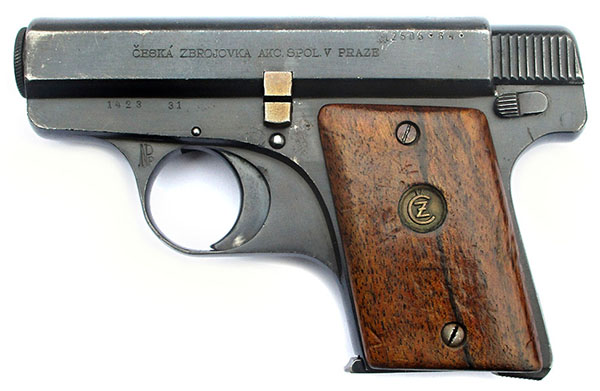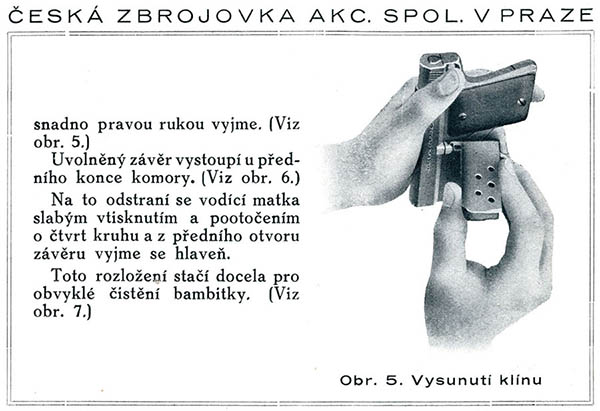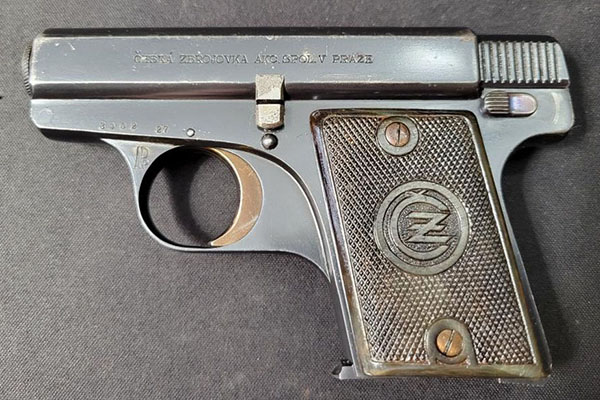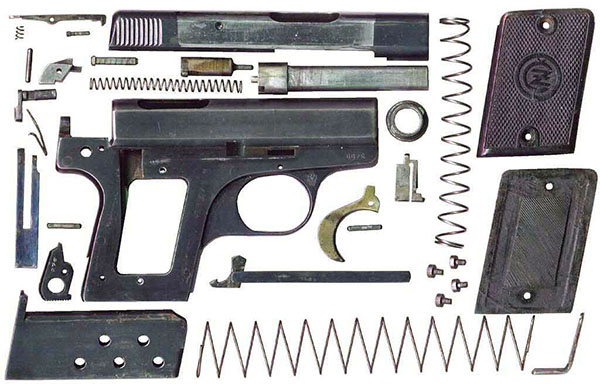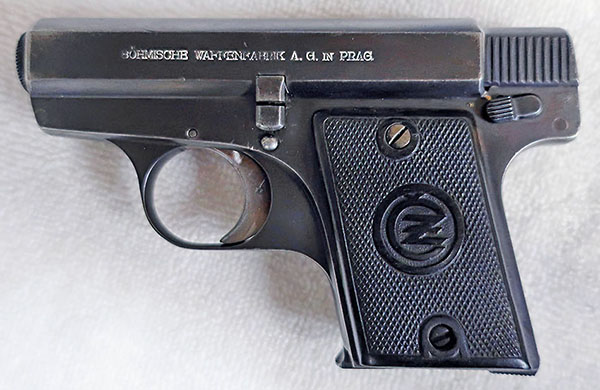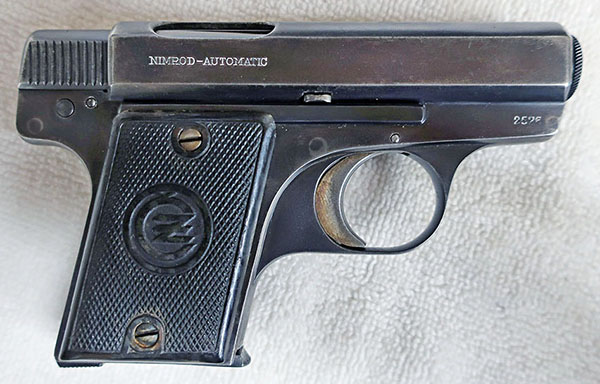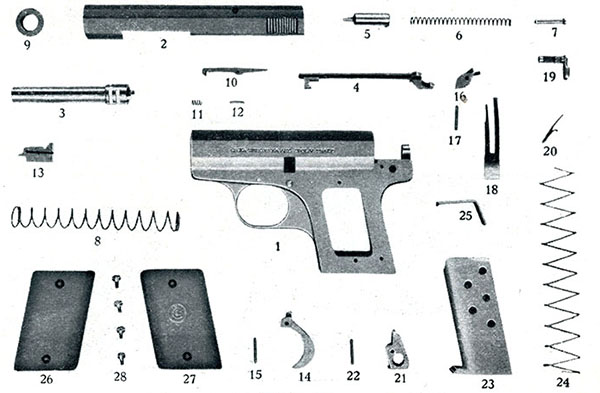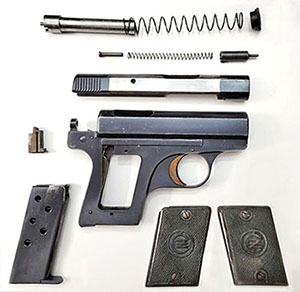 |
|||||||||||||||||||||||||||||||||||||||||||||||||||||||||||||||||||||||||||||||||||||||||||||||||||||||||||||||||||||||||||||||||||||||||||||||||||||||||||||||||||||||||||||||||||||||||||||||||||||||||||||||||||||||||||||||||||||||||||||||||||||||||||||||||||||||||||||||||||||||||||||||||||||||||||||||||||||||||||||||||
|
The Fox Pistol and by Ed Buffaloe and Jan Skramoušský
The republic of Czechoslovakia was formed in the aftermath of World War I, and existed from 1918 to 1992. In those seven decades the country created an advanced arms industry of considerable renown. Prior to the founding of the republic, the largest and only major arms company in Bohemia was the Skoda Works in Pilsen, which made heavy artillery, mortars, and Salvator-Dormus machine guns during World War I. After the war Skoda became an industrial giant that manufactured machine tools, locomotives, aircraft, ships, turbines, equipment for power plants, and almost any kind of machinery. In the interwar period, Československá zbrojovka in Brno developed into the country’s second largest arms company, specializing in the manufacture of military rifles. Česká zbrojovka of Strakonice became the third most important arms company in Czechoslovakia, though its origins were relatively humble. Today, Česká zbrojovka (ČZ) is known worldwide as a manufacturer of quality self-loading handguns, and, for a time, it was also an important manufacturer of rifles, light and heavy machine guns, machine gun accessories, automatic rifles, motorcycles, and signal pistols for infantry and air force. ČZ was formed from two originally independent companies, Jihočeská zbrojovka and Hubertus. Jihočeská zbrojovka (1919–1921) Jihočeská zbrojovka was officially founded, on 1 November 1919, under the name K. Bubla, akciová společnost na výrobu zbraní (K. Bubla joint stock company for the production of weapons), though some activity took place in the first half of 1919 before the company was officially organized. Later, under the terms of a partnership agreement dated 7 April 1920, the company was renamed Jihočeská zbrojovka, společnost s ručením omezeným (South Bohemia Arms Limited Liability Company), with a capitalization of 1.2 million crowns. The first company executives were Karel Bubla, an architect and builder/developer in Pilsen; Jiří Černý, a large landowner in Malevice; Otokar Polák, director of the České Budějovice Bank; and Alois Tomíška, a Czech gunsmith and designer who was the company's first technical director. Major investors in the company included Jiří Černý (200,000 crowns), Růžena Bublová and Marie Poláková (150,000 crowns each), Alois Tomiška and Jaroslav Císař of Malevice (100,000 crowns). There were additional investors who provided sums of up to 50,000 crowns each. The purpose of the company was the production of firearms of all kinds, components and materials necessary for their production, hunting supplies, the trade in such items, the establishment and maintenance of a shooting range, participation in shooting enterprises, the founding of such enterprises, and acquisition and monetization of patents in the firearms field.
The original headquarters of Jihočeská zbrojovka was in rented rooms of the former Halbmayr's steam mill in Pilsen, at No. 8 Prokopova Street, where the production of several types of pistols designed by Alois Tomiška was established. In regard to the Pilsen factory, Jaroslav Lugs states: “About 20 workers and four other employees worked there under the direction of Alois Tomiška, who was the designer of the pistol and himself a gunsmith. The pistols were made by hand until 1920, when the plant was equipped with machine tools similar to those intended for the works at Strakonice. At the end of April 1921 and before the new factory was completely ready, production was transferred from Pilsen to Strakonice.”
In February 1920, the construction of a permanent factory had begun in Strakonice. The site was chosen because Strakonice was also the location of the Pošumavské závody treated lumber company, which was simultaneously founded by Karel Bubla and other investors in Jihočeská zbrojovka. Additionally, Strakonice was a ready source of cheap labor for both enterprises. Hubertus (1919-1923) Továrna na výrobu zbraní, akciová společnost (Arms Factory Joint Stock Company) was founded in Prague, with a capitalization of approximately 1,500,000 crowns, by Rudolf Beran, Member of Parliament and Secretary of the Agrarian Party; Dr. Josef Černý, lawyer and member of parliament; Veleslav Hák, director of the Czechoslovak Union of Beekeepers; Jan Pulkrábek, director of the insurance company Assicurazioni Generali; Josef Šulc, director of the Slovak Banking Company; and Count Max Wratislaw. The purpose of the company was the manufacture of hunting weapons of all kinds, including shotguns, automatic rifles, and hunting equipment; trade in all products of the gun industry, and related products; the warehousing of goods for import and export; the establishment, acquisition, or hiring of plants and equipment to monetize the sale of company goods; and participation in related foreign enterprises. On 1 November 1919, the company took over the inventory of Josef Wenisch & Company of Prague at a price of 160,000 crowns, and was renamed Hubertus. Josef Wenisch & Company was a retailer of hunting rifles, shotguns, ammunition, and other shooting supplies at No. 7 Panská Street in Prague, whose sole owner at the time of the sale was Max Wenisch. Wenisch was supposed to retain a lifetime leadership role in Hubertus, but was eventually forced out, which led to four years of legal wrangling over compensation for the loss of his job. At the time of sale, Wenisch had been negotiating the acquisition of factory premises in Vejprty in order to begin production a proprietary line of hunting rifles. Hubertus went ahead with the purchase of the building in Vejprty, then purchased 721,994 crowns worth of machinery from Ludwig Löwe of Berlin, repaired the building, and purchased office equipment to furnish it. By May of 1920 the factory in Vejprty employed 25 gunsmiths and had produced about 90 hunting rifles. On 9 April 1921 the company’s share capital was increased to 5 million crowns, with the intent of expanding and automating rifle production in Vejprty. Hubertus then leased a large retail space in Prague, which it lavishly remodeled and opened on 12 June 1921. In mid-April of 1920, Alois Tomiška visited Max Wenisch and informed him of Jihočeská zbrojovka’s intention to produce 10,000 pocket pistols, and offered Hubertus exclusive rights to their sale. Hubertus was willing to pay one-third of the cost, if 1,000 pistols were produced in Pilsen by the end of June 1920 and the remaining 9,000 pistols by the end of February 1921. However, this was completely unrealistic, due to production problems in Pilsen. Merger of Hubertus and Jihočeská zbrojovka (1921) In April 1921 Jihočeská zbrojovka moved its workers from the old mill in Pilsen to the new factory in Strakonice, which was still in the final stages of construction. Production of pistols in Pilsen had been extremely slow, with ongoing quality control issues. Sales were almost nonexistent, especially considering the amount of money being spent. By November 1921, Hubertus was made aware of serious production and financial issues at Jihočeská zbrojovka. Representatives of the Skoda Works in Pilsen acted as mediators to induce the two companies to form a merger. At the end of 1921, Jihočeská zbrojovka employed forty-five workers and six apprentices. Hubertus approved the potential merger at a board meeting on 13 December 1921, and Jihočeská zbrojovka held a similar meeting on 28 December and also approved it. The new company was to be known as Česká zbrojovka (Czech, or Bohemian, Arms). Share capital was increased to 8 million crowns, with approval to issue new shares and increase capitalization to 20 million crowns upon approval of the merger by the state administration.
Patents Records remaining from the early days of the company are scattered and often contradictory. All known documentation points to Alois Tomiška as the designer of the Fox pistol, even though it bears little resemblance to his other designs and was never patented under his name. Its exact origin in time is uncertain. It may reach as far back as April 1919, when Jindřich Flossmann was hired as the first master gunsmith by the K. Bubla company, or possibly earlier.
The first documented hint of the gun appears in an early Czech patent, № 2055, filed on 8 November 1919 by Arthur Schweinburg and granted 15 June 1920. This patent covers a rubber recoil buffer, or alternative spring steel guide rest, for the firing pin guide rod of a self-loading pistol. The gun shown in the patent drawing appears to be a Fox prototype with a folding trigger, but no latch for it. The shape of the frame, shape of the sear, and position of the safety lever reflect those of the Fox. There is no record of Schweinburg working for K. Bubla or Jihočeská zbrojovka. He was a Czech engineer who subsequently took out European patents for such diverse items as die casting machines, snap fasteners for shoes, and an improved bird cage.
The actual patent for the design of the Fox pistol, Czech patent № 10,132, was filed on 18 March 1920, under the name Jan Hüttner, the foreman at Jihočeská zbrojovka. This patent, for a “self loading automatic pistol,” was granted on 15 December 1922. The patent covers the stamped and formed sheet metal frame which surrounds the bolt and barrel, the wedge which connects the barrel to the frame, and the folding trigger and its release lever. By the time the patent was issued the Fox pistol had already been superseded by the Model 1922. It remains a mystery why the patent was not filed under Tomiška’s name, if he were the inventor. Design of the Fox Pistol
The Fox pistol’s construction is atypical and differs from other pistols chambered in 6.35 mm Browning. The unlocked breech Fox has a stamped and formed sheet metal frame reinforced with three pinned inserts—one forming the front of the grip, the second forming the rear grip strap, and the third covering the space beneath the barrel and containing the trigger and its spring catch. The third insert is milled at the rear to accept the locking wedge. An internal slide moves inside the upper housing of the frame, which serves as the cover and guide for the slide. At the rear of the slide is a scalloped, serrated gripping area that protrudes from the upper frame housing and is used to cock the mechanism and chamber a round. In front of the gripping area of the slide is the breech block, containing the striker and its spring and guide.
A conventional magazine is held by a latch at the base of the grip. The magazine has a heavy base pinned to the side walls. The toe of the base is machined to a fine point to be used as a tool for removing the locking wedge. There is no magazine safety. The Fox has a raised front sight in a half-moon shape, and a raised rear sight. In later guns the rear sight appears to be dovetailed into the frame, but this is not evident in early guns. The Fox pistol is striker fired, with an external transfer bar on the right side. An upward projection at the rear of the transfer bar serves as a disconnector that positively prevents firing when the slide is out of battery. There is a forked flat spring at the rear—the bottom of this spring tensions the magazine release, the left fork tensions the sear, and the right fork tensions the transfer bar. A thumb operated manual safety on the left side serves to lock the sear. The serial number is on the right side of the frame, near the front. The left side of the upper frame housing has the following inscription: Jihoceskâ zbrojovka ve Strakonicich pat. pistol „Fox“
A very late Fox pistol is known to have a ČZ inscription, as follows: Patent Fox Production
The majority of Fox production seems to have taken place in 1921, when 173 pistols were recorded as being proofed. An inventory list made by engineer Bartsch at the end of February 1922 records 572 complete but unfinished Fox pistols, 637 complete magazines, a total of 643 slides in various stages of development, and 248 poorly made barrels in the plant. A year later, during the last week of March 1922, fifty pistols were shown as completed, but only 12 were functional. Fifteen Fox pistols are recorded to have been proofed in 1922. In total, only 197 Fox pistols were ever proofed in Czechoslovakia. It is true that adherence to proof law was a bit lax in the early days of the republic, so a number of guns may have gone unproofed, or may have been exported for proofing in other countries. There is a record of 350 Fox pistols being shipped to Vienna in conjunction with Alois Tomiška’s business trip there in May 1921. Perhaps these pistols were intended for proofing in Vienna, but no further evidence of them exists at this time.
Serial numbers known to the authors run from 1085 through 1514. We do not know for certain where the serial number range began, but none have been documented with three digits. Fox pistols are vanishingly scarce today, so it seems unlikely that 1500 working pistols were ever actually completed. Based on known serial numbers 500 or maybe 600 seems a more likely figure. There are several unserialized Fox pistols known—some of which are likely prototypes. One Fox pistol in the possession of the Military History Institute in Prague was converted to shoot .22, and there is a single large gun chambered in 7.65 mm Browning, with the serial number 1, also in possession of the Military History Institute. Johann Gugenberger tried and failed to get Fox production organized systematically during his one year tenure beginning 16 March 1921. Under Gugenberger's leadership, drawings were made of at least 184 devices necessary to automate production at the Strakonice facility, but construction of these devices was painstakingly slow. After a year on the job, with little progress, Gugenberger was relieved of his position. On 17 March 1922, the Russian engineer Anatoly Petrovič Zaljubovský took Gugenberger’s place as supervisor of pistol production.
The decision to change the folding trigger to a more conventional design with a fixed trigger and trigger guard was made on 19 June 1922 at a meeting of the company directorate. The change in design required the fabrication of an additional 98 instruments. All drawings and documentation were completed by 18 August 1922, and production was expected to begin in November with a projected daily production of 80 guns per shift. By mid-November 1922, 500 units were in process, and the factory had carried out tolerance tests on the first 25 pistols with satisfactory results.
The redesigned pistol requires only two inserts to complete the frame. Otherwise, the Model 1922 functions exactly like the Fox. A single insert fills the area beneath the barrel, forming the trigger guard and the front of the grip; another insert forms the rear grip strap. Raised sights are eliminated in favor of a groove on top of the pistol with a tiny front sight milled into it. The grasping area at the rear of the slide is simplified and has courser serrations. 250 barrels were ordered from Suhl, Germany, and a small quantity of circular brass ČZ monograms were ordered from the Anýž company of Prague.
Walnut stocks were were made with a brass ČZ monogram inset on the left stock. The company also placed an order with the Karva company for checked bakelite stocks with the ČZ monogram, which are seen on the majority of Model 1922 pistols. The company still had 1200 pairs of Fox stocks on hand, but they had the wrong initials on them and could not be used. Engineer Eugen Bartsch and Alois Tomíška wrote an instruction manual for the new gun.
By the beginning of March 1923, four-hundred ČZ Model 22 pistols had been completed and, by the end of August, 871 guns had been finished, of which the factory sold 570 pistols direct to customers, while the Prague shop on Wenceslas Square sold 161. Prague arms dealers and gunsmiths J. Nowotný, J. Jiráček, Zdeněk and the Lověna gunsmiths' association accepted the pistols for sale on commission. On 27 April 1923, the Czechoslovak military invited ČZ to bid on a contract for 20,000 9 mm army pistols, but such a contract would require financial resources that the company did not have. In a letter dated 4 May 1923 the Česká průmyslova a hospodárská banka in Prague warned the company that its debt had reach 15.5 million crowns. The rifle plant in Vejprt was unable to compete with cheaper foreign weapons. Česká zbrojovka was verging on bankruptcy. But long before any military contract could be issued, ČZ was required to prove that it could manufacture pistols with fully interchangeable parts.
A. P. Zaljubovský’s production reforms were put to the test on 23 May 1923, when a group of senior military officers came to inspect the Strakonice plant to see if it were suitable for the manufacture of the 9 mm Czech army pistol vz. 22. As told by František Myška: [T]he commission randomly selected ten assembled ČZ 6.35 pistols and put them all through a function test—they all worked fine. These pistols were no longer allowed out of their sight. Next followed a test of component interchangeability. ...under the strict supervision of the military commission, the listed ten pistols were disassembled—the parts were put on the stand and mixed by the commission (I note that the parts were not marked in any way). Now before the eyes of the commission all ten pistols were reassembled. Now a very serious event was ahead—will it work or there will be some glitches and all of us, including the director, prayed in our hearts that it would work out, because it was a salvation not only for our armory, but for all employees. After assembly, the pistols and cartridges went into the hands of a member of the commission, who tested the function of each pistol with two magazines. The guns worked flawlessly. The joy was great not only on our side, but also on the side of the military commission. On the basis of this test, the military commission then decided to transfer the production of the 9 mm army pistol from the Brno Armory to the Strakonice Armory.
On 13 June 1923, ČZ accepted the military order, despite its being too small to be profitable, on condition that they receive a considerable cash advance and, assuming the guns met the needs of the military, the company was to receive a further order for at least 100,000 pistols, or the military would be required to buy the production equipment. A contract was eventually drawn up on these terms, giving ČZ a cash advance of 3,700,000 crowns. The company was saved. By the end of 1923, 1,130 Model 22 pistols were produced, with an average weekly assembly of around 34 pieces. This increased the following year, as production was ramped up; so the plant produced an average of around 65 pistols per week. 1925 was the last year in which Model 22 pistols were produced. While it is true that the factory needed to prioritize preparations for production of the army pistol vz. 24, the reason that Model 1922 pistol production ended was because the factory had completed the original quantity intended. In April 1920 Alois Tomiška had told Max Wenisch that his company intended to produce 10,000 pocket pistols; in 1921 they ordered 11,000 stamped frames and 10,000 forged inserts, and by 1925 these parts had mostly been used. By 15 March 1925, the factory reported completion of 8903 pistols, of which 7400 remained in inventory; the number of pistols sold was recorded as 1503. The number produced, as listed in factory records, does not correspond exactly with surviving weekly production reports, nor with Prague proofhouse records. The factory recorded a total of 9121 pistols assembled by the end of 1932, but a number were incomplete, so the true number produced appears to be 9099. Prague proofhouse records show that a total of 8044 were proofed from 1923 through 1935. Numbering of the Model 1922 was in the same series as the Fox pistol. The highest serial number known at this time is 11,298.
The Model 1922 inventory was sold off gradually over the decade after 1925. The Brno police purchased 67 in 1928, the Uzhhorod police purchased another 78, and the Košice police purchased 22 in 1930. As of 15 September 1930, the factory still had 2,378 pistols in stock. The Czech Ministry of Justice purchased 14 in July 1931. In August 1931, the company Nimrod from Krýr u Rakovník ordered a total of 120 pistols for 18,000 crowns. These pistols were marked on the right side of the body with the inscription NIMROD-AUTOMATIC and the left side inscription was in German. The order was apparently completed at the end of the year, as it was listed among pending issues as late as November 1931. In its report from the end of 1937, ČZ stated that it had sold a total of 186 pistols to police departments and a total of 105 to various institutions.
In October 1932, there were still 1,328 pistols in the ČZ warehouse, but at the end of the same year, the number was reduced to 985. In early 1933, the factory had 890 left, but by the end of the same year, there were only 283 left. In 1933, ČZ sent price lists to various garrison headquarters, offering the gun for private purchase by officers and sergeants alongside the army pistols vz. 24 and vz. 27 for the price of 220 crowns. A spare magazine could be purchased for 15 crowns and a leather belt holster cost 20 crowns. In February 1934, there were still 275 Model 1922 pistols left in the factory. In March 1935, there were 71. At the end of May, only 21 remained, so 1935 ended their history for good. The gun was hardly a commercial success. Domestic sales were slow because foreign guns were cheaper. The overall economic situation of the post-war years was also a factor, because fewer people could afford to buy a gun. In addition, under laws inherited from the Austro-Hungarian empire, guns shorter than seven inches required a license to own, further limiting sales.
Like the Fox, the serial number of the ČZ Model 1922 is found on the right side of the frame, near the front. The inscription, on the left side of the upper frame housing, is in all capital serif characters, as follows: ČESKÁ ZBROJOVKA AKC. SPOL. V PRAZE Guns sold in the German-speaking world are marked: BOHMISCHE WAFFENFABRIK A.G. IN PRAG Berger points out that the Model 1922 pistols are marked either Praze or Prag, because the business office of Ceska Zbrojovka was in Prague, while the factory was in Strakonice. Karl Pawlas lists both a Model 1922 and 1923, but the only apparent difference is the stocks. Tibor Dite lists them as variants, rather than separate models. Field Stripping the CZ-22
Reassembly is in reverse order. The barrel has three lugs on the bottom. Insert the locking wedge to catch the center barrel lug. Push the wedge into the frame until fully engaged. If hand pressure does not suffice, a small wooden or rubber mallet may be used to seat the wedge.
|
|||||||||||||||||||||||||||||||||||||||||||||||||||||||||||||||||||||||||||||||||||||||||||||||||||||||||||||||||||||||||||||||||||||||||||||||||||||||||||||||||||||||||||||||||||||||||||||||||||||||||||||||||||||||||||||||||||||||||||||||||||||||||||||||||||||||||||||||||||||||||||||||||||||||||||||||||||||||||||||||||
|
Copyright 2007-2024 by Ed Buffaloe. All rights reserved |
|||||||||||||||||||||||||||||||||||||||||||||||||||||||||||||||||||||||||||||||||||||||||||||||||||||||||||||||||||||||||||||||||||||||||||||||||||||||||||||||||||||||||||||||||||||||||||||||||||||||||||||||||||||||||||||||||||||||||||||||||||||||||||||||||||||||||||||||||||||||||||||||||||||||||||||||||||||||||||||||||
|
|
|||||||||||||||||||||||||||||||||||||||||||||||||||||||||||||||||||||||||||||||||||||||||||||||||||||||||||||||||||||||||||||||||||||||||||||||||||||||||||||||||||||||||||||||||||||||||||||||||||||||||||||||||||||||||||||||||||||||||||||||||||||||||||||||||||||||||||||||||||||||||||||||||||||||||||||||||||||||||||||||||
